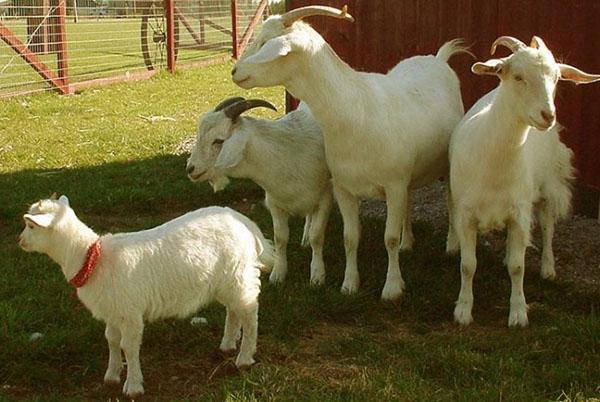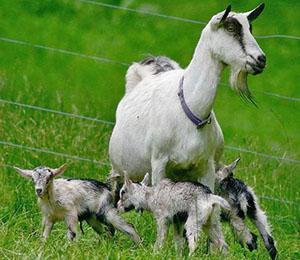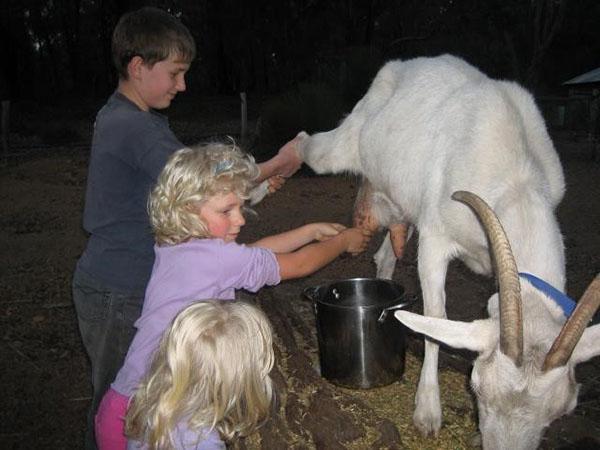Breeding goats at home for beginners
 Keeping dairy goats will provide the family with a healthy hypoallergenic drink. Breeding goats at home for novice breeders will not seem difficult. Of all the pets, the goat is considered the most unpretentious. However, a restless animal can spoil the relationship between neighbors for a long time, if negligent in the content.
Keeping dairy goats will provide the family with a healthy hypoallergenic drink. Breeding goats at home for novice breeders will not seem difficult. Of all the pets, the goat is considered the most unpretentious. However, a restless animal can spoil the relationship between neighbors for a long time, if negligent in the content.
Read also the article:Vietnamese pigs - breeding, care, nutrition!
How to start keeping a goat in a household

Have chosen a future wet nurse - arrange her residence. Keeping goats at home for novice breeders is easy to organize. Typically, goats are kept half in stall and range. The shed will need to be dry and free of drafts. There should be a thick layer of bedding, a bench or a block on the floor for lying in a clean, dry place. In a flock, the goat is kept loose.
 Hay in the trough and water in the basin is the minimum set. If the goat is drifting, the owner must know the time of lambing. If young animals are bought, females are kept separately and the first mating occurs at the age of one and a half years.
Hay in the trough and water in the basin is the minimum set. If the goat is drifting, the owner must know the time of lambing. If young animals are bought, females are kept separately and the first mating occurs at the age of one and a half years.
The yield of offspring directly depends on the origin of the producer. If he was born from a dairy goat, the offspring will also have a lot of milk in the udder.
If the newborn is taken to a warm house immediately after lambing, the mother will not accept him. She has to lick every lamb.
 In summer, goats are grazed or fed with freshly cut grass. But the unlimited growth of hooves will force at least 4 hours a day to walk the animal or regularly grind the hooves. When there is no pasture, hay, compound feed and root crops are used. In winter, the lack of hay when feeding goats with compound feed cannot be replaced. The temperature in the flock should not fall below 100 C, for newborn kids, at least 12 degrees.
In summer, goats are grazed or fed with freshly cut grass. But the unlimited growth of hooves will force at least 4 hours a day to walk the animal or regularly grind the hooves. When there is no pasture, hay, compound feed and root crops are used. In winter, the lack of hay when feeding goats with compound feed cannot be replaced. The temperature in the flock should not fall below 100 C, for newborn kids, at least 12 degrees.
The pen where the goat was placed must be strong. She will definitely explore all corners and try to leave. If the goat makes a further route through the fence to the neighbors, there will be a scandal. Animals are grazed in herds under the supervision of a goat-keeper, or tied to a peg. They talk affectionately with animals, treating them with a crust of bread and salt.
 An unpretentious animal eats:
An unpretentious animal eats:
- weeds after weeding;
- kitchen waste;
- chopped root vegetables;
- straw, hay, meadow grass.
The minimum information about breeding goats at home gives an idea of goats for a beginner. In the future, you will need to acquire skills in caring, get acquainted with the diet of feeding and raising kids.
Breeding, keeping, caring for goats at home
 Good strong offspring are obtained from a goat in the early spring period. To do this, mating should be carried out in early autumn. A goat in hunting happens with a male not on a related line. If mating has not occurred, after 15-22 days the animal will worry again. The offspring will appear in 147-150 days. You need to take the kids right.They wipe the baby, remove mucus from the nose and mouth, let the goat lick, apply to the udder or milk colostrum in the first hour after birth. If the temperature in the maternity ward is less than 15 degrees, the kids are taken to a warm room and the umbilical cord is treated and disinfected with iodine. If the kids are suckled, they stay with their mother in a warm room and then the milk goes to feed the suckers. When breeding goats, suckling specimens give healthier and more numerous offspring. When creating a herd, milk can be donated in the first year.
Good strong offspring are obtained from a goat in the early spring period. To do this, mating should be carried out in early autumn. A goat in hunting happens with a male not on a related line. If mating has not occurred, after 15-22 days the animal will worry again. The offspring will appear in 147-150 days. You need to take the kids right.They wipe the baby, remove mucus from the nose and mouth, let the goat lick, apply to the udder or milk colostrum in the first hour after birth. If the temperature in the maternity ward is less than 15 degrees, the kids are taken to a warm room and the umbilical cord is treated and disinfected with iodine. If the kids are suckled, they stay with their mother in a warm room and then the milk goes to feed the suckers. When breeding goats, suckling specimens give healthier and more numerous offspring. When creating a herd, milk can be donated in the first year.
With artificial feeding, the kids after birth are not allowed near the mother's udder and are fed from the teat. In order not to make a mistake in feeding the kids from the first days of life, use the table.
At three months, the baby already becomes an adult and receives food from a different diet. At five months, young goats already start hunting. To give a young body to grow stronger, mating is allowed after one and a half years.
The table shows how to feed the kids at 2 months, how to gradually accustom the kids to cereals, concentrates and root crops.
Three month old goats should receive feed and supplements:
- green forage from grass, shrub branches;
- rough - hay, straw, dry birch brooms;
- fermented green mass - silage;
- compound feed;
- crushed grain;
- vitamins and minerals.
You need to keep the goats separately and castrate them in time. Keeping a dairy goat near the goat will give the milk an unpleasant odor. Therefore, the goat's aviary should be away from the dairy herd.
 Adult animals should receive food that is seasonally balanced. Summer grass in pastures is irreplaceable. But it is impossible to graze animals in swampy areas, hooves will hurt. However, except for goats, no one can cope with clearings overgrown with bushes, steep mountain slopes, inconveniences. The goat will find food where large animals cannot crawl through. They gladly eat the young aftermath after harvesting the fields. An adult animal eats 6-7 kg per day, kids 2-4 kg of grass. If there is little feed in the fields, animals need to be fed in the evenings. There should always be a lick from the pen and drink twice a day.
Adult animals should receive food that is seasonally balanced. Summer grass in pastures is irreplaceable. But it is impossible to graze animals in swampy areas, hooves will hurt. However, except for goats, no one can cope with clearings overgrown with bushes, steep mountain slopes, inconveniences. The goat will find food where large animals cannot crawl through. They gladly eat the young aftermath after harvesting the fields. An adult animal eats 6-7 kg per day, kids 2-4 kg of grass. If there is little feed in the fields, animals need to be fed in the evenings. There should always be a lick from the pen and drink twice a day.
 In winter, goats eat dry feed, root crops and mixed feed. But brooms prepared in summer will become a delicacy and a vitamin supplement. Spruce and birch branches, oak and hazel - everything is suitable for feeding the goat herd. Drinks and food during the stall period should be warm. A mixture of bone meal and salt is added to each feed as a mineral supplement. Outdoor walks are a must.
In winter, goats eat dry feed, root crops and mixed feed. But brooms prepared in summer will become a delicacy and a vitamin supplement. Spruce and birch branches, oak and hazel - everything is suitable for feeding the goat herd. Drinks and food during the stall period should be warm. A mixture of bone meal and salt is added to each feed as a mineral supplement. Outdoor walks are a must.
To prevent the animals from suffering from skin parasites in winter, it is necessary to comb the goat every other day, once a week to moisten the wool with a solution of soda to protect it from lice. Hooves should be trimmed during the stall period.
Breeding goats at home for novice breeders will be the first step in providing a family with natural healing products and down.